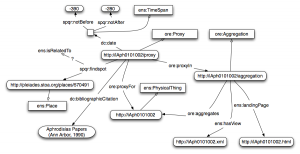We are having a very productive week here in London. It started with all hands meeting on Monday and continues with more focused discussions. We went through all the datasets with our prospective end users and identified metadata properties that could potentially overlap and give us a chance for meaningful data integration and possibly some inferencing. Next to the obvious spatiotemporal properties (findspots, dates) we have object form type (bowl, jar, coin), material, color, text class (contract, dedication) and several types of persons. The precise set of vocabularies is yet to be defined, but we had a quick go and designed a small graph trying to use Europeana Data Model (see image).
This exercise generated some questions. We will seek answers to these questions on the Europeana WP3 mailing list.

